
The Lamiaceae or Labiatae are a family of flowering plants commonly known as the mint, deadnettle or sage family. Many of the plants are aromatic in all parts and include widely used culinary herbs like basil, mint, rosemary, sage, savory, marjoram, oregano, hyssop, thyme, lavender, and perilla, as well as other medicinal herbs such as catnip, salvia, bee balm, wild dagga, and oriental motherwort. Some species are shrubs, trees, or, rarely, vines. Many members of the family are widely cultivated, not only for their aromatic qualities, but also their ease of cultivation, since they are readily propagated by stem cuttings. Besides those grown for their edible leaves, some are grown for decorative foliage. Others are grown for seed, such as Salvia hispanica (chia), or for their edible tubers, such as Plectranthus edulis, Plectranthus esculentus, Plectranthus rotundifolius, and Stachys affinis. Many are also grown ornamentally, notably coleus, Plectranthus, and many Salvia species and hybrids.

Leonotis is a genus of flowering plants in the family Lamiaceae. One species, Leonotis nepetifolia, is native to tropical Africa and southern India. It is naturalized throughout most of the tropics. The other species are endemic to southern + eastern Africa.
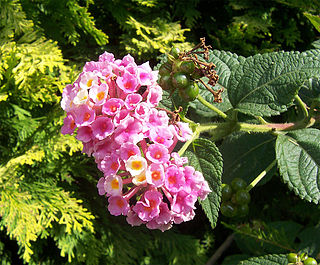
The Verbenaceae, the verbena family or vervain family, is a family of mainly tropical flowering plants. It contains trees, shrubs, and herbs notable for heads, spikes, or clusters of small flowers, many of which have an aromatic smell.

Dillenia is a genus of flowering evergreen or semi-evergreen trees and shrubs in the family Dilleniaceae, native to tropical and subtropical regions of southern Asia, Australasia, and the Indian Ocean islands.

Volkameria is a genus of flowering plants in the family Lamiaceae. It is pantropical in distribution. Many of the species are found in coastal habitats.

Vitex is a genus of flowering plants in the sage family Lamiaceae. It has about 250 species. Common names include chaste tree or chastetree, traditionally referring to V. agnus-castus, but often applied to other species, as well.
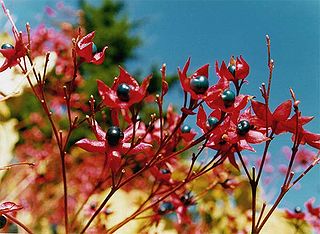
Clerodendrum is a genus of flowering plants formerly placed in the family Verbenaceae, but now considered to belong to the Lamiaceae (mint) family. Its common names include glorybower, bagflower and bleeding-heart. It is currently classified in the subfamily Ajugoideae, being one of several genera transferred from Verbenaceae to Lamiaceae in the 1990s, based on phylogenetic analysis of morphological and molecular data.
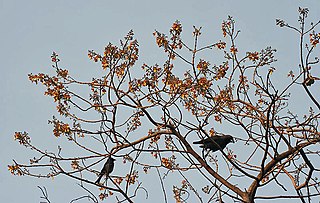
Gmelina is a genus of plants in the family Lamiaceae. It consists of about 35 species in Australia, New Guinea, New Caledonia, Southeast Asia, India and a few in Africa. Some species such as G. arborea have been planted and/or become naturalised in India, Africa and Australia. It was named by Carl Linnaeus in honour of botanist Johann Georg Gmelin.

Oxera is a genus of flowering plants in the family Lamiaceae native to Vanuatu and New Caledonia in the western Pacific.
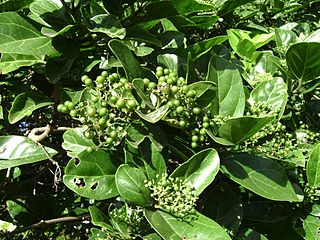
Premna is a genus of flowering plants in the mint family, Lamiaceae, first described for modern science in 1771. It is widespread through tropical and subtropical regions in Africa, southern Asia, northern Australia, and various islands in the Pacific and Indian Oceans.
- Premna acuminataR.Br. - Australia, New Guinea
- Premna acutataW.W.Sm. - southwestern China
- Premna albaH.J.Lam - Palau
- Premna ambongensisMoldenke - Madagascar
- Premna amplectensWall. ex Schauer - Thailand, Myanmar
- Premna angolensisGürke - tropical Africa
- Premna angustifloraH.J.Lam - Palau
- Premna annulataH.R.Fletcher - Thailand, Laos, Vietnam
- Premna aureolepidotaMoldenke - Madagascar
- Premna balakrishnaniiA.Rajendran & P.Daniel - Tamil Nadu
- Premna balansaeDop - Vietnam
- Premna barbataWall. ex Schauer - Indian Subcontinent, Myanmar
- Premna bengalensisC.B.Clarke - Indian Subcontinent, Myanmar, Vietnam
- Premna bequaertiiMoldenke - Uganda, Rwanda, Zaïre
- Premna bracteataWall. ex C.B.Clarke - Himalayas, Tibet, Yunnan, Nepal, Assam, Bhutan, Myanmar
- Premna cambodianaDop - Cambodia, Vietnam
- Premna cavalerieiH.Lév - China
- Premna chevalieriDop - Thailand, Laos, Vietnam, China
- Premna chrysoclada(Bojer) Gürke - Kenya, Tanzania, Guinea-Bissau
- Premna collinsaeCraib - Thailand
- Premna confinisC.Pei & S.L.Chen ex C.Y.Wu - China
- Premna congolensisMoldenke - Zaïre, Angola, Cabinda
- Premna cordifoliaRoxb. - Thailand, Vietnam, Malaya
- Premna coriaceaC.B.Clarke - Indian Subcontinent, Thailand, Andaman Islands
- Premna corymbosaRottler - India, Sri Lanka, Andaman & Nicobar Islands
- Premna crassaHand.-Mazz. - Vietnam, China
- Premna debianaA.Rajendran & P.Daniel - Arunachal Pradesh
- Premna decaryiMoldenke - Madagascar
- Premna decurrensH.J.Lam - Indonesia
- Premna discolorVerdc. - Kenya
- Premna dubiaCraib - Laos, Thailand, Vietnam
- Premna esculentaRoxb. - Assam, Bangladesh, Myanmar, Thailand
- Premna fohaiensisC.Pei & S.L.Chen ex C.Y.Wu - China (Yunnan)
- Premna fordiiDunn - China
- Premna fulvaCraib - Indochina, Indonesia, China
- Premna garrettiiH.R.Fletcher - Thailand
- Premna glaberrimaWight - southern India
- Premna glandulosaHand.-Mazz. - China (Yunnan)
- Premna gracillimaVerdc. - Kenya, Tanzania
- Premna grandifoliaA.D.J. Meeuse, illegitimate name, = Premna hutchinsonii
- Premna grossaWall. ex Schauer - Myanmar
- Premna guillauminiiMoldenke - New Caledonia
- Premna hainanensisChun & F.C.How - China (Hainan)
- Premna hans-joachimiiVerdc. - Tanzania
- Premna henryana(Hand.-Mazz.) C.Y.Wu - China
- Premna herbaceaRoxb. - Himalayas, Yunnan, Indian Subcontinent, Southeast Asia, Indonesia, New Guinea, northern Australia
- Premna hildebrandtiiGürke - Zaire, Kenya, Tanzania, Mozambique, Zimbabwe
- Premna hispidaBenth. - West Africa
- Premna humbertiiMoldenke - Madagascar
- Premna hutchinsoniiMoldenke - Ivory Coast
- Premna interruptaWall. ex Schauer - southern China, Himalayas, Indochina
- Premna jalpaigurianaT.K.Paul - West Bengal
- Premna khasianaC.B.Clarke - Assam, Thailand
- Premna lepidellaMoldenke - Madagascar
- Premna ligustroidesHemsl - China
- Premna longiacuminataMoldenke - Madagascar
- Premna longifoliaRoxb. - Himalayas
- Premna longipetiolataMoldenke - Madagascar
- Premna lucensA.Chev. - West Africa
- Premna macrophyllaWall. ex Schauer - Assam, Indochina
- Premna madagascariensisMoldenke - Madagascar
- Premna mariannarumSchauer - Mariana Islands
- Premna matadiensisMoldenke - Zaïre, Angola
- Premna maximaT.C.E. Fr. - Kenya
- Premna mekongensisW.W.Sm. - China (Yunnan)
- Premna micranthaSchauer - India, Assam, Bangladesh
- Premna microphyllaTurcz. - Japan, Ryukyu Islands, China
- Premna millefloraC.B.Clarke - Assam
- Premna milneiBaker - Nigeria, Bioko
- Premna minorDomin - Queensland
- Premna mollissimaRoth - Indian Subcontinent, Yunnan, Indochina, Philippines
- Premna mooiensis(H.Pearson) W.Piep - Mozambique, Eswatini, South Africa
- Premna mortehaniiDe Wild - Zaïre
- Premna mundanthuraiensisA.Rajendran & P.Daniel - Tamil Nadu
- Premna neurophyllaChiov. - Ethiopia
- Premna oblongataMiq. - Indonesia, Philippines
- Premna odorataBlanco - - Indian Subcontinent, Yunnan, Southeast Asia, New Guinea, northern Australia; naturalized in Miami-Dade County in Florida
- Premna oliganthaC.Y.Wu - China
- Premna oligotrichaBaker - Ethiopia, Somalia, Kenya, Tanzania
- Premna orangeanaCapuron - Madagascar
- Premna paisehensisC.Pei & S.L.Chen - China (Guangxi)
- Premna pallescensRidl.- Borneo, Indonesia
- Premna parasiticaBlume - Indonesia
- Premna parvilimbaC.Pei - China (Yunnan)
- Premna paucinervis(C.B.Clarke) Gamble - Kerala, Tamil Nadu
- Premna paulobarbataH.J.Lam - Mariana Islands
- Premna perplexansMoldenke - Madagascar
- Premna perrieriMoldenke - Madagascar
- Premna pinguisC.B.Clarke - Assam, Bangladesh, Myanmar, Java
- Premna politaHiern - Angola
- Premna procumbensMoon - India, Bangladesh, Sri Lanka
- Premna protrusaA.C.Sm. & S.Darwin - Fiji
- Premna puberulaPamp. - China
- Premna pubescensBlume - Indonesia, Philippines, Christmas Island
- Premna puerensisY.Y.Qian - China (Yunnan)
- Premna punduanaWall. ex Schauer - Arunachal Pradesh, Assam, Bangladesh
- Premna puniceaC.Y.Wu - China (Yunnan)
- Premna purpurascensThwaites - Sri Lanka
- Premna quadrifoliaSchumach. & Thonn. - West Africa
- Premna rabakensisMoldenke - Cambodia
- Premna regularisH.J.Lam - Philippines, Indonesia, New Guinea
- Premna repensH.R.Fletcher - Thailand
- Premna resinosa(Hochst.) Schauer - East Africa, Arabian Peninsula, India
- Premna richardsiaeMoldenke - Tanzania
- Premna rubroglandulosaC.Y.Wu - China (Yunnan)
- Premna scandensRoxb. - China (Yunnan), Himalayas, Andaman Island, Indochina
- Premna schimperiEngl - East Africa
- Premna schliebeniiWerderm. - Tanzania, Mozambique
- Premna scoriarumW.W.Sm. - Tibet, Yunnan, Myanmar
- Premna senensisKlotzsch - eastern + central Africa
- Premna serrataH.R.Fletcher - Thailand
- Premna serratifoliaL. - widespread in East Africa, the Indian Subcontinent, Southeast Asia, northern Australia, islands of Pacific + Indian Oceans
- Premna siamensisH.R.Fletcher - Thailand
- Premna stenobotrysMerr. - Vietnam
- Premna steppicolaHand.-Mazz. - China
- †Premna sterculiifoliaKing & Gamble - Malaya but extinct
- Premna straminicaulisC.Y.Wu - China (Yunnan)
- Premna subcapitataRehder - China
- Premna sulphurea(Baker) Gürke - Angola
- Premna sunyiensisC.Pei - China (Guangdong)
- Premna szemaoensisPei - China (Yunnan)
- Premna tahitensisJ.Schauer - many islands of the Pacific
- Premna tanganyikensisMoldenke - Tanzania, Mozambique
- Premna tapintzeanaDop - China (Yunnan)
- Premna teniiC.Pei - China (Yunnan)
- Premna thoreliiDop - Laos
- Premna thwaitesiiC.B.Clarke - Sri Lanka
- Premna tomentosaWilld. - Indian Subcontinent, Southeast Asia, Queensland, Solomon Islands
- Premna trichostomaMiq. - Southeast Asia, Indonesia, New Guinea
- Premna urticifoliaRehder - China (Yunnan)
- Premna velutinaGürke - Burundi, Kenya, Tanzania, Mozambique
- Premna venulosaMoldenke - Madagascar
- Premna wightianaSchauer - India, Sri Lanka
- Premna wuiBoufford & B.M.Barthol. - China (Yunnan)
- Premna yunnanensisW.W.Sm - China

Rotheca myricoides is a species of flowering plant in the family Lamiaceae. It is native to Africa and widely cultivated elsewhere. In cultivation, it is frequently known by one of its synonyms, such as Clerodendrum myricoides.

Ehretia is a genus of flowering plants in the borage family, Boraginaceae. It contains about 50 species. The generic name honors German botanical illustrator Georg Dionysius Ehret (1708–1770).

Clerodendrum speciosissimum is a tropical shrub of the family Lamiaceae, native to Indonesia and Papuasia, but now naturalized in parts of Latin America, Africa, the Caribbean, Seychelles, and Florida.

Rotheca serrata, commonly known as the blue fountain bush, the blue-flowered glory tree or the beetle killer, is a species of flowering plants in the family Lamiaceae. It is native to India, Sri Lanka and Malaysia.
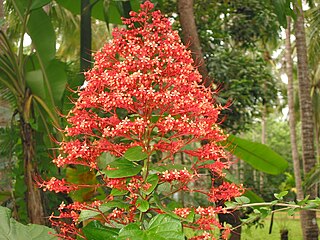
Clerodendrum paniculatum, the pagoda flower, is a species of flowering plant in the genus Clerodendrum and family Lamiaceae. It is native to tropical Asia and Papuasia, Fiji, and French Polynesia. It is introduced in Central America.

Karomia is a genus of plants in the family Lamiaceae. The genus was introduced in 1932 by the botanist Paul Louis Amans Dop (1876–1954) in "Bulletin du Muséum national d'histoire naturelle" (Paris) ser. 2. 4: 1052, for the single species Karomia fragrans. It is native to eastern and southern Africa, Madagascar, and Vietnam.
- Karomia fragransDop – Vietnam
- Karomia gigas(Faden) Verdc. – Kenya, Tanzania
- Karomia humbertii(Moldenke) R.Fern. – Madagascar
- Karomia macrocalyx(Baker) R.Fern. – Madagascar
- Karomia madagascariensis(Moldenke) R.Fern. – Madagascar
- Karomia microphylla(Moldenke) R.Fern. – Madagascar
- Karomia mira(Moldenke) R.Fern. – Madagascar
- Karomia speciosa(Hutch. & Corbishley) R.Fern. – Mozambique, Eswatini, South Africa
- Karomia tettensis(Klotzsch) R.Fern. – Mozambique, Malawi, Zimbabwe, Zambia

Hiram Wild was an English botanist who worked in Southern Rhodesia. The standard author abbreviation Wild is used to indicate this person as the author when citing a botanical name.

















